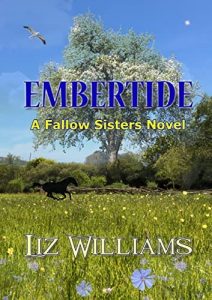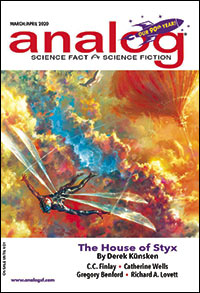Gary K. Wolfe Reviews Embertide by Liz Williams
 Embertide, Liz Williams (Newcon 978-1-914953-21-7, $16.99, 346pp, tp) June 2022.
Embertide, Liz Williams (Newcon 978-1-914953-21-7, $16.99, 346pp, tp) June 2022.
Writers of both fantasy and historical fiction have long recognized the British landscape as a palimpsest, maps upon older maps upon older maps, but in fantasy it’s another sort of palimpsest as well, disguising hidden worlds just below the surface of what we can perceive. It’s a tradition refined and extended in various ways by writers as diverse as Arthur Machen, Robert Holdstock, Susan Cooper, Diana Wynne Jones, and Graham Joyce. To bring this sort of thing off well requires an acute sense of landscape, the stylistic grace needed to make that landscape pop like a Constable painting, and characters congenial enough to draw us in. Right now, the most rewarding addition to this venerable tradition is Liz Williams’s Fallow Sisters series, which began with Comet Weather (2020) followed by last year’s Blackthorn Winter, and now by Embertide (which appeared this summer). In that first novel, Williams introduced us to the freelance DJ Stella, the fashion designer Serena, the wandering free spirit Luna, and Bee, who maintains the family estate, Mooncote, in Somerset and is the most down-to-earth of the sisters, despite having a boyfriend who is a 400-year-old Elizabethan ghost. All are capable of occasional shapeshifting or drifting off into other times or other realities, but their mother, Alys, who has a tendency to disappear for months at a time, seems most embedded in the various fae worlds that surround them.
The series has so far followed a clear chronology, with Comet Weather taking place around a fall harvest festival and Blackthorn Winter roughly around the period between Christmas and Twelfth Night. Blackthorn Winter also shifted the narrative more unequivocally toward the fantastic, and Embertide, which takes place at the end of winter and the beginning of spring, shifts it further still: The sisters barely have time to get on with their daily lives before being yanked into the past or into one of the elusive fae realms that none of them quite understand. “There were huge gaps in everyone’s knowledge of this patchwork country,” Luna muses. “All of them were holders of jigsaw pieces, but no one seemed to know what the full puzzle looked like.” The pieces quickly multiply. Serena, in Brighton where her actor boyfriend Ward is shooting a movie, finds herself first in WWII era Brighton – where she finds a dead airman – and then in the Victorian era; Stella, now living with her friend Evie in a barge on the Thames, is told by an angel in the form of a magpie to track down the mysterious Book of London; Bee discovers ominous white tendrils growing on land owned by her wealthy neighbor Nick Wratchall-Hayes, and is later attacked by a goat-face man; Luna, though pregnant and trying to avoid stress, finds herself along with her boyfriend Ben nearly trampled by a herd of ghost cattle until rescued by another mysterious figure, Kit Coral.
Eventually, the main antagonists become clear, and more threatening. Chief among them is Miranda, a successful actress and Ward’s former girlfriend, who seems able to pop up in almost any historical era, but more ominous are the Hounds – also referred to as the Lily White Boys, which sounds like a deliberately contemporary reference but is actually from the ancient folk song “Green Grow the Rushes O” – and the Searchers, associated with the ravens of the Tower of London. While the plot at times begins to seem overcomplicated – almost no character or event is a throwaway, and even that dead airman Serena finds has a role later on – some of the set pieces are genuinely haunting, as when Stella drifts back in time while visiting St. Paul’s, watching it shrink into an ancient Roman temple of Diana and then to an even earlier state, associated with the Celtic figure of Noualen, who becomes an important ally. With Luna’s pregnancy still unresolved, I expect we’ll see yet another volume in the series, possibly ending out the year with a summer setting, and maybe holding out a promise of some sort of closure for the coolest sisters in contemporary fantasy.
Gary K. Wolfe is Emeritus Professor of Humanities at Roosevelt University and a reviewer for Locus magazine since 1991. His reviews have been collected in Soundings (BSFA Award 2006; Hugo nominee), Bearings (Hugo nominee 2011), and Sightings (2011), and his Evaporating Genres: Essays on Fantastic Literature (Wesleyan) received the Locus Award in 2012. Earlier books include The Known and the Unknown: The Iconography of Science Fiction (Eaton Award, 1981), Harlan Ellison: The Edge of Forever (with Ellen Weil, 2002), and David Lindsay (1982). For the Library of America, he edited American Science Fiction: Nine Classic Novels of the 1950s in 2012, with a similar set for the 1960s forthcoming. He has received the Pilgrim Award from the Science Fiction Research Association, the Distinguished Scholarship Award from the International Association for the Fantastic in the Arts, and a Special World Fantasy Award for criticism. His 24-lecture series How Great Science Fiction Works appeared from The Great Courses in 2016. He has received six Hugo nominations, two for his reviews collections and four for The Coode Street Podcast, which he has co-hosted with Jonathan Strahan for more than 300 episodes. He lives in Chicago.
This review and more like it in the November 2022 issue of Locus.
 While you are here, please take a moment to support Locus with a one-time or recurring donation. We rely on reader donations to keep the magazine and site going, and would like to keep the site paywall free, but WE NEED YOUR FINANCIAL SUPPORT to continue quality coverage of the science fiction and fantasy field.
While you are here, please take a moment to support Locus with a one-time or recurring donation. We rely on reader donations to keep the magazine and site going, and would like to keep the site paywall free, but WE NEED YOUR FINANCIAL SUPPORT to continue quality coverage of the science fiction and fantasy field.
©Locus Magazine. Copyrighted material may not be republished without permission of LSFF.







